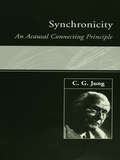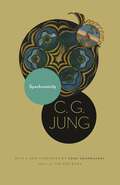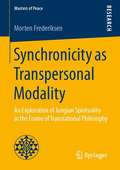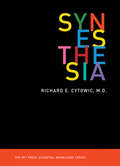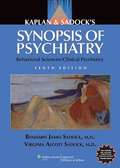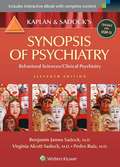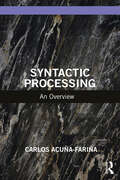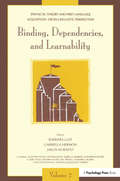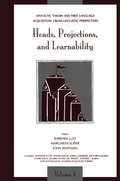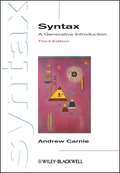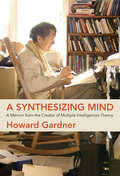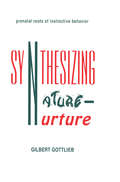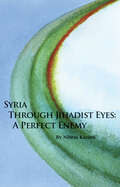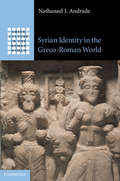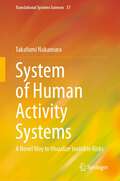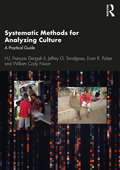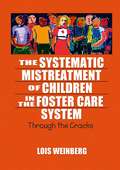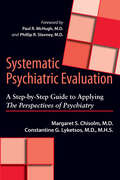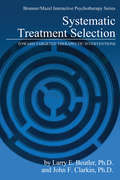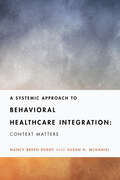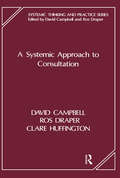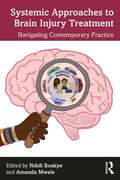- Table View
- List View
Synchronicity: An Acausal Connecting Principle (Jung Extracts Ser. #598)
by C. G. JungTo Jung, synchonicity is a meaningful coincidence in time, a psychic factor which is independant of space and time. This revolutionary concept of synchronicity both challenges and complements the physicist's classical view of casualty. It also forces is to a basic reconsideration of the meaning of chance, probability, coincidence and the singular events in our lives.
Synchronicity: An Acausal Connecting Principle. (From Vol. 8. of the Collected Works of C. G. Jung) (Jung Extracts #30)
by C. G. JungJung was intrigued from early in his career with coincidences, especially those surprising juxtapositions that scientific rationality could not adequately explain. He discussed these ideas with Albert Einstein before World War I, but first used the term "synchronicity" in a 1930 lecture, in reference to the unusual psychological insights generated from consulting the I Ching. A long correspondence and friendship with the Nobel Prize-winning physicist Wolfgang Pauli stimulated a final, mature statement of Jung's thinking on synchronicity, originally published in 1952 and reproduced here. Together with a wealth of historical and contemporary material, this essay describes an astrological experiment Jung conducted to test his theory. Synchronicity reveals the full extent of Jung's research into a wide range of psychic phenomena. This paperback edition of Jung's classic work includes a new foreword by Sonu Shamdasani, Philemon Professor of Jung History at University College London.
Synchronicity as Transpersonal Modality: An Exploration of Jungian Spirituality in the Frame of Transrational Philosophy (Masters Of Peace Series)
by Morten FrederiksenThe author explores Carl Gustav Jung’s elusive notion of synchronicity from a transrational perspective and relates synchronicity to the transpersonality of the "All-One". This is done by expanding the content and meaning of Wolfgang Dietrich´s layers of Elicitive Conflict Mapping (ECM) through re-relating them to Ken Wilber´s model of the structures of consciousness; with synchronicity as the literal connecting principle. The result, then, is an expanded notion of the transrational peace philosophy which includes Wilber´s model of stages shorn of its evolutionary slant and fathoms synchronicity in its theoretical outlook and practical application.
Synesthesia: A Union of the Senses
by Richard E. CytowicA detailed study of synesthesia, an involuntary joining of the senses in which information from one sense joins a perception from another
Synesthesia (The MIT Press Essential Knowledge Series)
by Richard E. CytowicAn accessible, concise primer on the neurological trait of synesthesia—vividly felt sensory couplings—by a founder of the field. One in twenty-three people carry the genes for the synesthesia. Not a disorder but a neurological trait—like perfect pitch—synesthesia creates vividly felt cross-sensory couplings. A synesthete might hear a voice and at the same time see it as a color or shape, taste its distinctive flavor, or feel it as a physical touch. In this volume in the MIT Press Essential Knowledge series, Richard Cytowic, the expert who returned synesthesia to mainstream science after decades of oblivion, offers a concise, accessible primer on this fascinating human experience. Cytowic explains that synesthesia's most frequent manifestation is seeing days of the week as colored, followed by sensing letters, numerals, and punctuation marks in different hues even when printed in black. Other manifestations include tasting food in shapes, seeing music in moving colors, and mapping numbers and other sequences spatially. One synesthete declares, “Chocolate smells pink and sparkly”; another invents a dish (chicken, vanilla ice cream, and orange juice concentrate) that tastes intensely blue. Cytowic, who in the 1980s revived scientific interest in synesthesia, sees it now understood as a spectrum, an umbrella term that covers five clusters of outwardly felt couplings that can occur via several pathways. Yet synesthetic or not, each brain uniquely filters what it perceives. Cytowic reminds us that each individual's perspective on the world is thoroughly subjective.
Synopsis of Psychiatry: Behavioral Sciences/Clinical Psychiatry (Tenth Edition)
by Benjamin J. Sadock Virginia A. SadockThe best-selling general psychiatry text since 1972, Kaplan and Sadock's Synopsis of Psychiatry is now in its thoroughly updated Tenth Edition. This complete, concise overview of the entire field of psychiatry is a staple board review text for psychiatry residents and is popular with a broad range of students in medicine, clinical psychology, social work, nursing, and occupational therapy, as well as practitioners in all these areas. The book is DSM-IV-TR compatible and replete with case studies and tables, including ICD-10 diagnostic coding tables. You will also receive access to the complete, fully searchable online text, an online test bank of approximately 100 multiple-choice questions and full answers, and an online image bank.
Synopsis Of Psychiatry: Behavioral Sciences/Clinical Psychiatry
by Benjamin James Sadock Pedro Ruiz Virginia A. SadockThe new and thoroughly updated 11th edition of Kaplan and Sadock's Synopsis of Psychiatry: Behavioral Sciences/Clinical Psychiatry is a complete overview of the entire field of psychiatry for clinicians, residents, students, and all others who provide mental health care. In this best-selling textbook in psychiatry for over 40 years, the reader will find a thorough discussion of both the behavioral sciences and clinical psychiatry. The 11th edition integrates all the DSM-5 criteria and provides a detailed and comprehensive overview of treatment methods for every known mental disorder. The 11th edition is set apart from any other reference you have and includes: DSM-5 diagnostic tables on every major psychiatric disorder. A psychopharmacology section organized according to mechanisms of action and updated to include all of the new drugs including those in preparation. Extensive use of case studies and illustrations to enhance the learning experience. The most current treatment methods including a description of all newly introduced psychotherapeutic techniques. A completely revised section on neurocognitive disorders organized along the DSM-5 model. An updated and expanded section on child psychiatry; now includes a guide to diagnosis and treatment of autism spectrum disorder and other disorders of childhood. A fully searchable eBook, bundled with the print. This publication is included on the ANCC: American Nurses Credentialing Center's reference list. The Synopsis of Psychiatry has been the leading clinical psychiatric resource for psychiatrists both in the US and around the world. It has the reputation of being an independent, accurate, reliable and objective compendium of new events in the field of psychiatry. Now in its 11th edition, the tradition continues, both in print and digital formats--from the authorities you can trust.
Syntactic Islands
by Cedric BoeckxThe phenomenon of the syntactic 'island' – a clause or structure from which a word cannot be moved – is central to research and study in syntactic theory. This book provides a comprehensive overview of syntactic islands. What are they? How do they arise? Why do they exist? Cedric Boeckx discusses the pros and cons of all the major generative accounts of island effects, and focuses the discussion on whether islands are narrowly syntactic effects, are due to interface factors or are 'merely' performance effects. Thanks to the diversity of island effects, readers are given a unique opportunity to familiarize themselves with all the major research styles and types of analysis in theoretical linguistics and have the chance to reflect on the theoretical implications of concrete natural language examples, allowing them to develop their own synthesis.
Syntactic Processing: An Overview
by Carlos Acuña-FariñaThis book provides an overview of the structures, topics and main theories of syntactic processing. It covers the last 40 years of sentence-level psycholinguistic research and debates and makes it accessible to both theoretical linguists and experimental psychologists. Tying linguistically relevant issues to psycholinguistic theory, this book: Covers the processing of the grammatical phenomena adjunction, agreement and gap filling and discusses the relationship between grammars and parsers Discusses experimental work and theories, demonstrating how psychologists have made real strides in understanding language and how studying the processing of syntactic structure is the same as studying the nature of language Explores the key theories of psycholinguistics, including recent developments Explains the different methodologies of sentence processing, such as eye-tracking and electroencephalography Bridging the gap between psycholinguistic research and the study of language, this book is essential reading for advanced students and scholars of linguistics and experimental psycholinguistics as well as cognitive science and psychology.
Syntactic Theory and First Language Acquisition: Cross-linguistic Perspectives -- Volume 1: Heads, Projections, and Learnability -- Volume 2: Binding, Dependencies, and Learnability
by Barbara Lust Gabriella Hermon Jaklin Kornfilt Suzanne Flynn Shyam Kapur Isabella Barbier Katharina Boser Claire Foley Zelmira Nuñez del Prado Edward J. Rubin Lynn Santelmann Jacqueline ToribioUniversal Grammar (UG) is a theory of both the fundamental principles for all possible languages and the language faculty in the "initial state" of the human organism. These two volumes approach the study of UG by joint, tightly linked studies of both linguistic theory and human competence for language acquisition. In particular, the volumes collect comparable studies across a number of different languages, carefully analyzed by a wide range of international scholars. The issues surrounding cross-linguistic variation in "Heads, Projections, and Learnability" (Volume 1) and in "Binding, Dependencies, and Learnability" (Volume 2) are arguably the most fundamental in UG. How can principles of grammar be learned by general learning theory? What is biologically programmed in the human species in order to guarantee their learnability? What is the true linguistic representation for these areas of language knowledge? What universals exist across languages? The two volumes summarize the most critical current proposals in each area, and offer both theoretical and empirical evidence bearing on them. Research on first language acquisition and formal learnability theory is placed at the center of debates relative to linguistic theory in each area. The convergence of research across several different disciplines -- linguistics, developmental psychology, and computer science -- represented in these volumes provides a paradigm example of cognitive science.
Syntactic Theory and First Language Acquisition: Cross-linguistic Perspectives -- Volume 1: Heads, Projections, and Learnability -- Volume 2: Binding, Dependencies, and Learnability
by Barbara Lust Margarita Suñer John Whitman Suzanne Flynn Shyam Kapur Isabella Barbier Katharina Boser Claire Foley Zelmira Nuñez del Prado Edward J. Rubin Lynn Santelmann Almeida Jacqueline ToribioUniversal Grammar (UG) is a theory of both the fundamental principles for all possible languages and the language faculty in the "initial state" of the human organism. These two volumes approach the study of UG by joint, tightly linked studies of both linguistic theory and human competence for language acquisition. In particular, the volumes collect comparable studies across a number of different languages, carefully analyzed by a wide range of international scholars. The issues surrounding cross-linguistic variation in "Heads, Projections, and Learnability" (Volume 1) and in "Binding, Dependencies, and Learnability" (Volume 2) are arguably the most fundamental in UG. How can principles of grammar be learned by general learning theory? What is biologically programmed in the human species in order to guarantee their learnability? What is the true linguistic representation for these areas of language knowledge? What universals exist across languages? The two volumes summarize the most critical current proposals in each area, and offer both theoretical and empirical evidence bearing on them. Research on first language acquisition and formal learnability theory is placed at the center of debates relative to linguistic theory in each area. The convergence of research across several different disciplines -- linguistics, developmental psychology, and computer science -- represented in these volumes provides a paradigm example of cognitive science.
Syntax: A Generative Introduction
by Andrew CarnieAndrew Carnie's bestselling textbook on syntax has guided thousands of students through the discipline of theoretical syntax; retaining its popularity due to its combination of straightforward language, comprehensive coverage, and numerous exercises.
Syntax
by Robert FreidinSyntax: Basic Concepts and Applications provides a systematic introduction to core topics in syntax, focusing on how the basic concepts apply in the analysis of sentences. Assuming no background in linguistic analysis, the book gives students a working knowledge of syntactic analysis from a minimalist perspective. Step by step it explains the fundamentals of phrase structure, movement and deletion. Well-placed exercises throughout reinforce and extend the concepts and analyses presented in the text, allowing readers to gain understanding of progressively complex issues at a comfortable pace. Much of the data comes from English, but crucial examples are also drawn from a range of other languages, including Russian, Chinese, Japanese, French, Italian, Spanish, Irish, Welsh and Greek.
A Synthesizing Mind: A Memoir from the Creator of Multiple Intelligences Theory
by Howard GardnerThe influential author and eminent authority on the human mind reflects on his groundbreaking work and the many forms of intelligence--including his own.Howard Gardner's Frames of Mind was that rare publishing phenomenon--a mind-changer. Widely read by the general public as well as by educators, this influential book laid out Gardner's theory of multiple intelligences. It debunked the primacy of the IQ test and inspired new approaches to education; entire curricula, schools, museums, and parents' guides were dedicated to the nurturing of the several intelligences. In his new book, A Synthesizing Mind, Gardner reflects on his intellectual development and his groundbreaking work, tracing his evolution from bookish child to eager college student to disengaged graduate student to Harvard professor.
Synthesizing Nature-nurture: Prenatal Roots of Instinctive Behavior (Distinguished Lecture Series)
by Gilbert GottliebThis volume provides a primarily nontechnical summary of experimental and theoretical work conducted over the course of 35 years which resulted in a developmental framework capable of integrating causal influences at the genetic, neural, behavioral, and ecological levels of analysis. It describes novel solutions to the nature-nurture problem at both the empirical and theoretical levels. Following field observations, laboratory experiments led to the discovery of the nonobvious prenatal experiential basis of instinctive behavior in two species--ground-nesting mallard ducklings and hole-nesting wood ducklings. This work also describes the experiences that lead to the rigid canalization of behavioral development as well as the social and sensory experiences that favor the continuance of flexibility. The author also describes in detail a developmental psychobiological systems view that supports a behaviorally and psychologically mediated pathway to evolutionary change in humans and other species. Written in a way that is readable to even the nonspecialist, the text is accompanied by numerous photographs that illuminate and add personal meaning to the written words. Readers will be engaged by the emphasis on the human aspect of the scientific enterprise.
Syria through Jihadist Eyes: A Perfect Enemy
by Nibras KazimiWith field notes accumulated in a Syrian environment not generally hospitable to research and inquiry, Nibras Kazimi provides a unique view of the Syrian regime and its base at home, filling a void in our understanding of the intelligence barons and soldiers who run that country. He offers a look at the tactical, propagandists and strategic ingredients required, in jihadist eyes, for a successful jihad—and whether those ingredients are available in Syria.
Syrian identity in the Greco-Roman world (Greek Culture In The Roman World Ser.)
by Nathanael J. AndradeBy engaging with recent developments in the study of empires, this book examines how inhabitants of Roman imperial Syria reinvented expressions and experiences of Greek, Roman and Syrian identification. It demonstrates how the organization of Greek communities and a peer polity network extending citizenship to ethnic Syrians generated new semiotic frameworks for the performance of Greekness and Syrianness. Within these, Syria's inhabitants reoriented and interwove idioms of diverse cultural origins, including those from the Near East, to express Greek, Roman and Syrian identifications in innovative and complex ways. While exploring a vast array of written and material sources, the book thus posits that Greekness and Syrianness were constantly shifting and transforming categories, and it critiques many assumptions that govern how scholars of antiquity often conceive of Roman imperial Greek identity, ethnicity and culture in the Roman Near East, and processes of 'hybridity' or similar concepts.
System of Human Activity Systems: A Novel Way to Visualize Invisible Risks (Translational Systems Sciences #37)
by Takafumi NakamuraThis book has unique features that set it apart from conventional books on the prevention of system failures in that it provides a method that views human activities from a meta-methodological perspective based upon an inter-disciplinary understanding of human activities. With these characteristics, the book also proposes a common methodological basis to apply to various problems surrounding society today such as an aging social infrastructure; the safety of food, medicine, and public transportation; and the creation of sustainable electricity and cybersecurity. Furthermore, since the failure of human activities is expressed in a three-dimensional space and the topological metrics are implemented, the failure trajectories can be quantitatively monitored in time series to take effective preventive measures. Considering the implementation of the topological metrics, the causes of each failure are classified into two dimensions of the degree of coupling between system elements and the interaction between the target system and the external environment. Owing to the nature of the introduction of topological metrics, all individual and diverse systems can share general topological metrics. Consequently, understanding various failures over cross-industries is possible with the use of common meta-systemic language and mutual learning between different industries, and the solution of social problems can be effectively achieved. A system of system failures (SOSF) proposed and confirmed the effectiveness of this meta-methodology for information and communication technologies (ICT) systems and the SOSF is extended to human activity systems (SOHAS: system of human activity systems) as a whole. Therefore, the SOHAS becomes an academic foundation for theoretical research on meta-methodology, and it has an impact on practitioners to prevent system failures by accumulating knowledge of failures and learning from other industries.
Systematic Methods for Analyzing Culture: A Practical Guide
by H.J. François Dengah II Jeffrey G. Snodgrass Evan R. Polzer William Cody NixonSystematic Methods for Analyzing Culture is a practical manual that provides step-by-step instruction for collecting and analyzing cultural data. This compact guide explains complex topics in straightforward and practical terms, via research examples, textual and visual software guides, and hands-on exercises. Through each chapter’s introductory examples, the manual illustrates how socially learned knowledge provides group members with shared understandings of the world, which allow for mutually intelligible interactions. The authors then carefully walk readers through the process of eliciting those socially learned, shared, and thus cultural representations of reality, which structure the thinking and practice of individuals inhabiting social groups. Specifically, the book shows how researchers can elicit such thought and behavior via methods such as free lists, pile sorts, cultural consensus and consonance analysis, textual analysis, and personal network research. The book will help both undergraduate and graduate students identify ways to unpack the "black box" of culture, which may be absent or given only cursory attention within their training and respective fields. The book’s clear and systematic step-by-step walkthroughs of each method will also encourage more established researchers, educators, and practitioners—from diverse fields and with varying levels of experience—to integrate techniques for assessing cultural processes into their research, teaching, and practice.
The Systematic Mistreatment of Children in the Foster Care System: Through the Cracks
by Lois WeinbergThe Systematic Mistreatment of Children in the Foster Care System tells the stories of 10 children in the foster care system from diverse ethnic and cultural backgrounds and the efforts by advocates to find them permanent places to live, appropriate schooling, and other essentials they need to survive. The children’s case studies highlight the difficulties in placing and maintaining them in healthy living situations with supportive educational, mental health, and other services. The book shows how children fall-sometimes over and over again-through the "deep cracks" that exist within and between the various agencies of the multi-agency system of care that was designed to help them. Appropriate placement and services for children in foster care typically requires the coordination and collaboration of several agencies, including the juvenile court, child protective services (CPS), school districts, and departments of mental health (DMH). The Systematic Mistreatment of Children in the Foster Care System shows how these agencies frequently fail to meet their legal obligations to children in the system and what can be done to address these failures-and the outcomes they produce. The Systematic Mistreatment of Children in the Foster Care System includes: an introduction to the child protective services system the general route by which children in the United States are removed from their parents’ custody because or abuse and neglect the major components of the Individuals with Disabilities Education Act and the problems in getting foster children’s educational needs met the difficulties in securing stable out-of-home placements strategies for stabilizing home placements problems in funding for out-of-home placements strategies for advocating the removal of children from inadequate out-of-home placements legislation and practices for bringing about needed policy changes and much more Equally valuable as a professional tool and as a classroom resource, The Systematic Mistreatment of Children in the Foster Care System includes introductions to specific issues presented in each chapter; case studies that illuminate the issues presented; subsections for each case study chapter entitled "Prevention," "Intervention," "Advocacy Considerations," and "What Had Gone Wrong;" boxed items highlighting practical strategies, laws, and other relevant information; and a conclusion and summary of each chapter.
Systematic Psychiatric Evaluation: A Step-by-Step Guide to Applying The Perspectives of Psychiatry
by Margaret S. Chisolm Constantine G. LyketsosTwo Johns Hopkins psychiatrists explain the Perspectives approach to evaluating patients with psychiatric disorders.The Perspectives approach to psychiatry focuses on four aspects of psychiatric practice and research: disease, dimensional, behavior, and lifestory. In Systematic Psychiatric Evaluation, Drs. Margaret S. Chisolm and Constantine G. Lyketsos underscore the benefits of this approach, showing how it improves clinicians' abilities to evaluate, diagnose, and treat patients.Drs. Chisolm and Lyketsos use increasingly complex case histories to help the mental health provider evaluate patients demonstrating symptoms of bipolar disorder, psychosis, suicidal ideation, depression, eating disorders, and cutting, among other conditions. The book also includes an exercise that simulates the Perspectives approach side by side with traditional methods, revealing the advantages of a method that engages not one but four points of view. Featuring a foreword by Drs. Paul R. McHugh and Phillip R. Slavney, the originators of the Perspectives approach, this innovative book will be used in psychiatric training programs as well as by practicing mental health clinicians.
Systematic Treatment Selection: Toward Targeted Therapeutic Interventions
by Larry E. Beutler John F. ClarkinFirst published in 1990. Routledge is an imprint of Taylor & Francis, an informa company.
A Systemic Approach to Behavioral Healthcare Integration: Context Matters (Fundamentals of Clinical Practice With Couples and Families Series)
by Dr. Nancy Breen Ruddy PhD Dr. Susan H. McDanielThis book provides clinicians, consultants, and healthcare administrators with a roadmap to establishing a systemic, patient-centered, family-oriented behavioral health service that is integrated into a healthcare setting. Healthcare that goes beyond biomedical issues to address our whole biopsychosocial selves, produces better outcomes for patients and families. Integrating behavioral health into medical settings requires an understanding of the interplay of multiple systemic layers in American healthcare. The existing literature on integration largely fails to address the "big picture" of integrated services and systems, including operations, clinical processes, and financial sustainability elements.A Systemic Approach to Behavioral Healthcare Integration summarizes the literature on the impact of integrating behavioral health care into medical settings, on the role of families in health maintenance and chronic disease management, and on team science and applying family systems theory/relational science to the teams that are now essential to healthcare.
A Systemic Approach to Consultation (The Systemic Thinking and Practice Series)
by David Campbell Ros Draper Clare HuffingtonA Systemic Approach to Consultation discusses the application of systemic thinking to work within organizations. The authors draw on their experiences of consulting with teams, departments and whole organizations in both the public and private sectors. They describe their work as an integrated approach called Development Consultation, which focuses on the beliefs and behaviors in the wider system which makes it difficult for organizations to manage their own processes of change. The authors then discuss the way they formulate systemic problems and the interventions, particularly the interviewing technique, which they have used in numerous case examples. The book is intended as a handbook for professionals from any discipline who are engaged in consultation work.
Systemic Approaches to Brain Injury Treatment: Navigating Contemporary Practice
by Amanda Mwale Ndidi BoakyeThis book is an exploration of key systemic and socio-political considerations when working with people whose lives have been impacted by neurological injury and those who care for them. Expert contributors consider the impact of intersectionality across domains that include gender, sexuality, class, education, religion and spirituality, race, culture, and ability/disability. It offers relevant literature in the field of neuropsychology as well as clinical case studies that provide inspiration and key reflections for clinicians, neurological specialist therapists, and medical staff alike. Chapters discuss navigating intersectionality in couple therapy, hidden social inequalities in paediatric neurorehabilitation, racial microaggression in inpatient settings, and more. This book is essential for all health and social-care practitioners working in the field of brain injury and chronic illness who want to challenge the status quo and advocate for diversity and inclusion.
